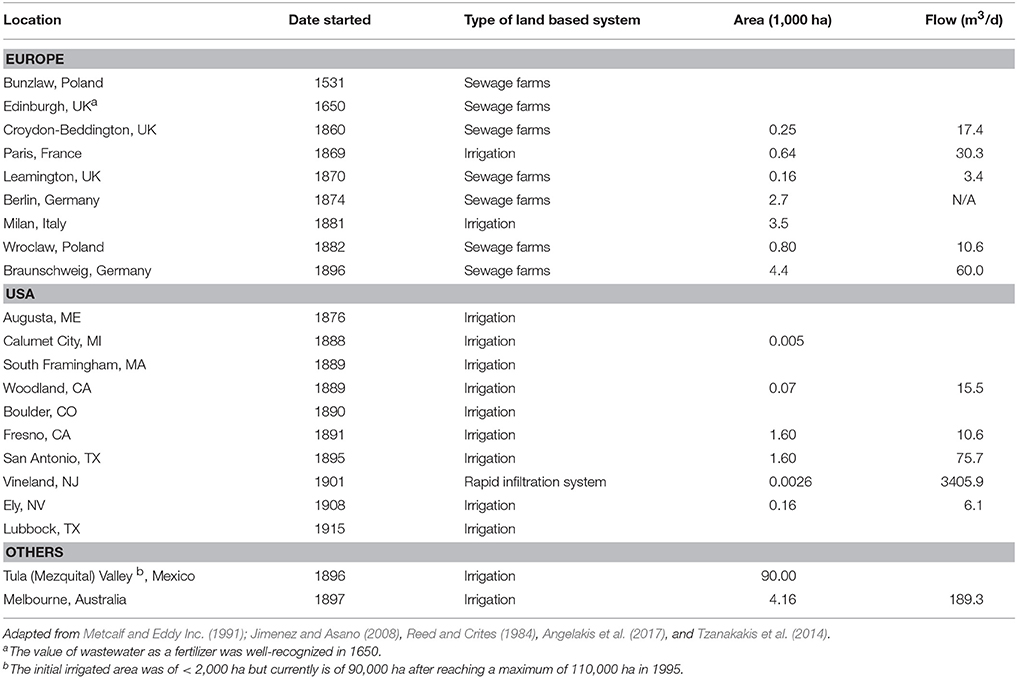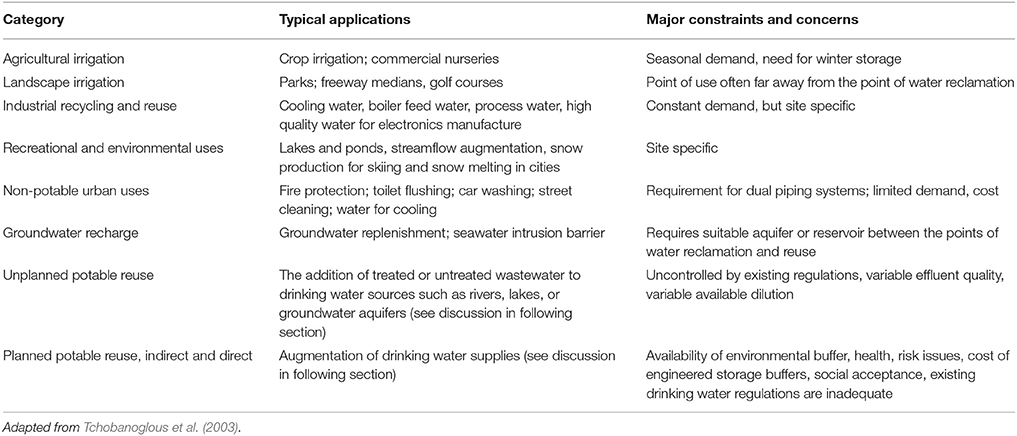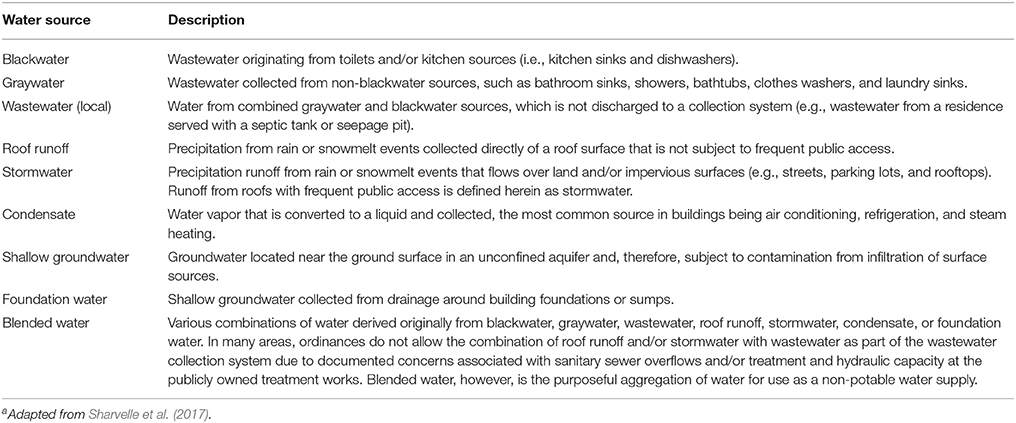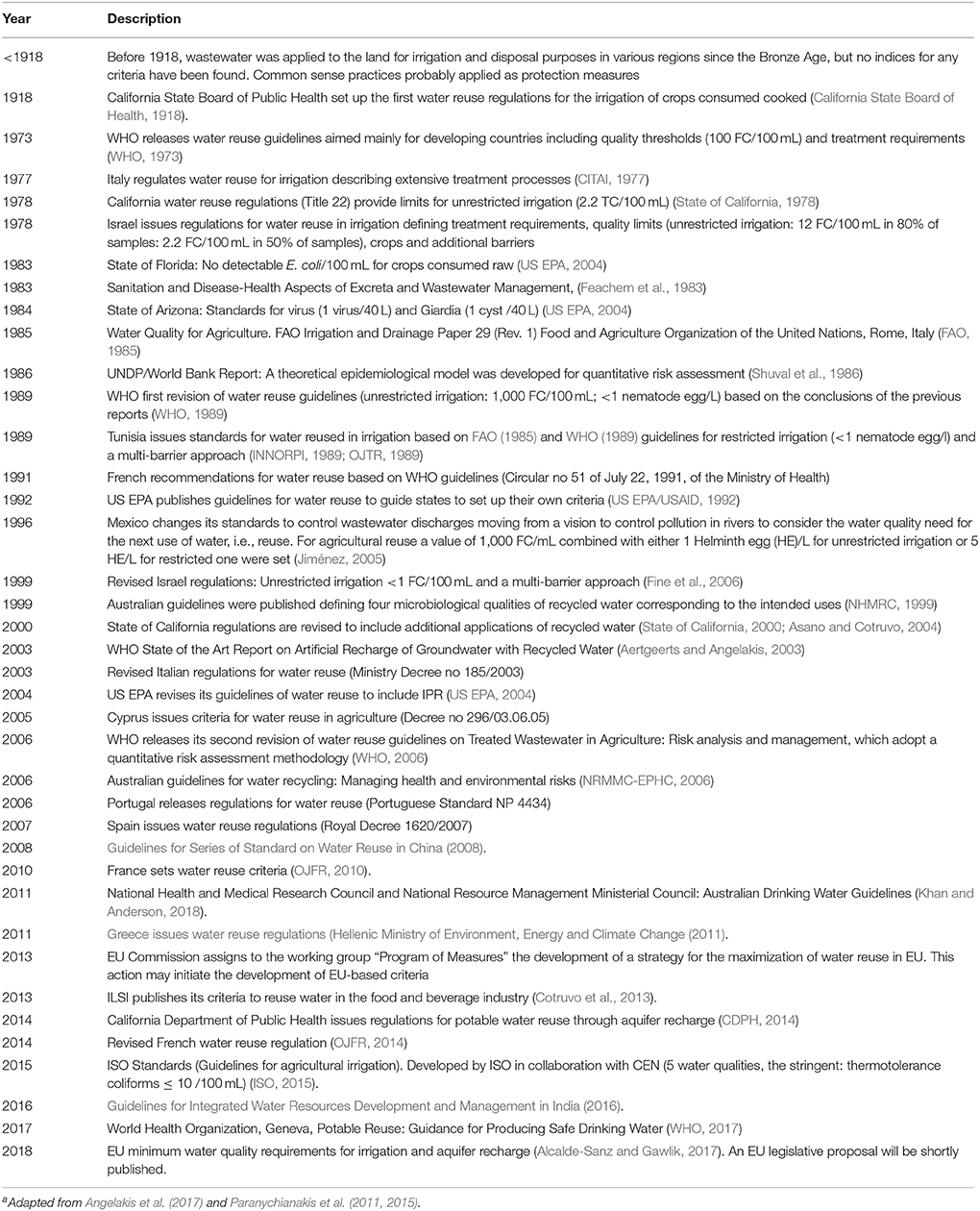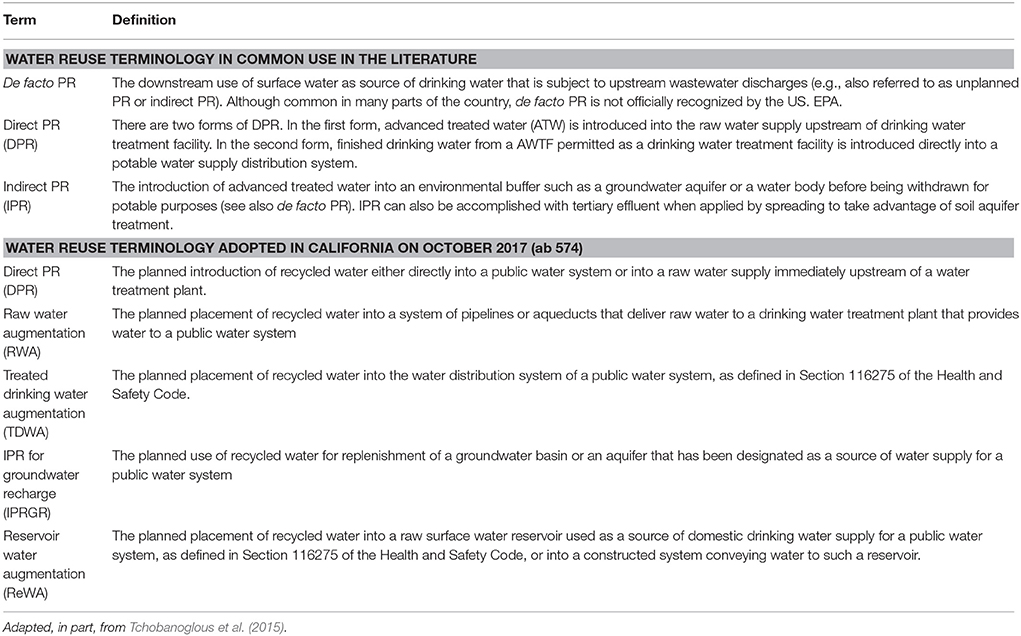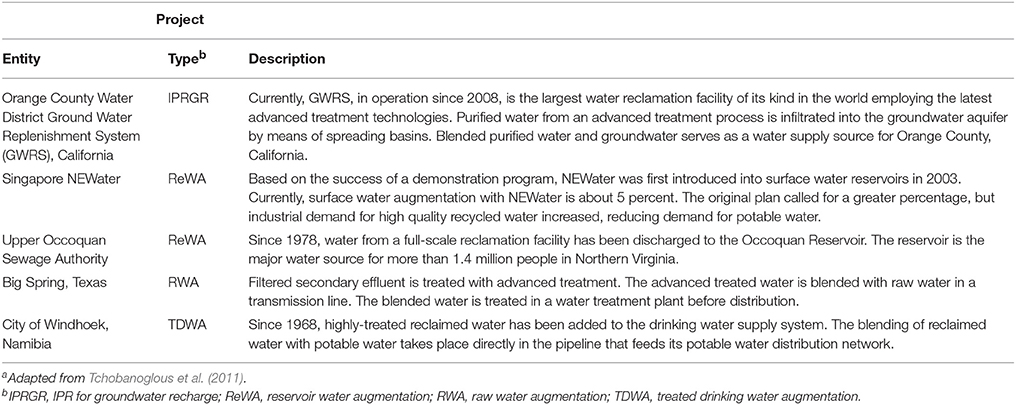Water Reuse: From Ancient to Modern Times and the Future
- 1Hellenic Union of Municipal Enterprises for Water Supply and Sewerage, Larissa, Greece
- 2Department of Water Resources, Institute of Crete, National Foundation for Agricultural Research, Iraklion, Greece
- 3Department of Civil and Environmental Engineering, University of California, Davis, Davis, CA, United States
- 4Department of Agricultural Engineering, Water and Forestry, National Agricultural Institute of Tunisia, Tunis, Tunisia
- 5Division of Water Sciences, UNESCO, Paris, France
- 6Department of Civil and Environnemental Engineering, University of California, Davis, Davis, CA, United States
From the beginning of the Bronze Age (ca. 3200–1100 BC), domestic wastewater (sewage) has been used for irrigation and aquaculture by a number of civilizations including those that developed in China and the Orient, Egypt, the Indus Valley, Mesopotamia, and Crete. In historic times (ca. 1000 BC−330 AD), wastewater was disposed of or used for irrigation and fertilization purposes by the Greek and later Roman civilizations, especially in areas surrounding important cities (e.g., Athens and Rome). In more recent times, the practice of land application of wastewater for disposal and agricultural use was utilized first in European cities and later in USA. Today, water reclamation and reuse projects are being planned and implemented throughout the world. Recycled water is now used for almost any purpose including potable use. This paper provides a brief overview of the evolution of water reuse over the last 5,000 years, along with current practice and recommendations for the future. Understanding the practices and solutions of the past, provides a lens with which to view the present and future.
Introduction
The more you look back in the past, the more you see into the future
Winston Churchill (1874–1965)
Water reuse is not a new technique or concept; knowledge on wastewater treatment and reuse has been accumulated along with the history of humankind. Land application of human waste is an old practice, which has undergone a number of development stages from ancient to contemporary times (Rose and Angelakis, 2014). Today, recycled water is used for nearly all purposes including potable reuse. In this paper, historical and current developments in water reuse are reviewed in three time periods: (a) in prehistoric to medieval times (ca. 3200 BC−1400 AD), (b) in early and mid-modern times (ca. 1400–1900 AD), and (c) in contemporary times (1900 AD-present). In light of information presented in the first three sections, the final two sections deal with the future including: (a) emerging trends and (b) issues and challenges in water reuse.
Water recycling from ancient to modern times is also the story of how water recycling evolved from ancient times to its decline with the development of intensified wastewater treatment methods in the late 1800s and early 1900s to its rebirth due to population growth, the development of megacities, climate change, rapid developments in technology, and the fact that the amount of fresh water in the world is finite. The information presented is intended to promote a new vision of water reuse and to highlight the important role water reuse will play in meeting future water needs, especially as the population of the world continues to grow.
Water Reuse in Prehistoric to Medieval Times (ca. 3200–1400 AD)
For most of the 200,000 years that modern humans (Homo sapiens) have dwelled on earth, they survived as hunter–gatherers (Vuorinen et al., 2007). As the population continued to increase, groups of people formed tribes for survival. In turn, with ever-increasing populations, tribes grouped together to form communities. The first human communities, which were relatively small, were scattered over wide areas and waste produced by them was returned to land and decomposed using natural cycles (Lofrano and Brown, 2010). Because the early communities were made up nomadic hunter–gatherers, disposal problems were limited because communities moved when existing conditions became unlivable.
Prehistoric Times (ca. 3200–1000 BC)
With the establishment of permanent settlements about 10,000 years ago, a new era began in which an agrarian way of life was needed to support the inhabitants of the community. Until the birth of the first advanced civilizations in the Bronze Age, the disposal of human excreta was managed in an ad hoc manner, either on the surface of the ground or in holes dug in the ground covered after use as explained by the Mosaic Law of Sanitation (Deuteronomy, Chapter 23) (Lofrano and Brown, 2010). The growth of permanent settlements led to the development of collection systems for both wastewater and stormwater. The first indications of the utilization of wastewater for irrigation and fertilization of agricultural lands extend back ca. 5,000 years to the Bronze Age civilizations (e.g., Minoan and Indus Valley) (Angelakis and Spyridakis, 1996; Asano and Levine, 1996; Levine et al., 2010; Tzanakakis et al., 2014). Minoans developed advanced sewerage systems to dispose of wastewater to rivers (e.g., Palaces of Knossos), to the sea (e.g., Palace of Zakros), or to agricultural land for irrigation and fertilization purposes (e.g., Palace of Phaistos and Villa of Hagia Triada). The end of the wastewater and stormwater collection system in the Palace of Phaistos, used to divert wastewater and stormwater to the farmland, is shown in Figure 1A. A cistern in the Villa of Hagia Triada used to collect and store water wastewater and drainage for agricultural purposes is shown in Figure 1B.
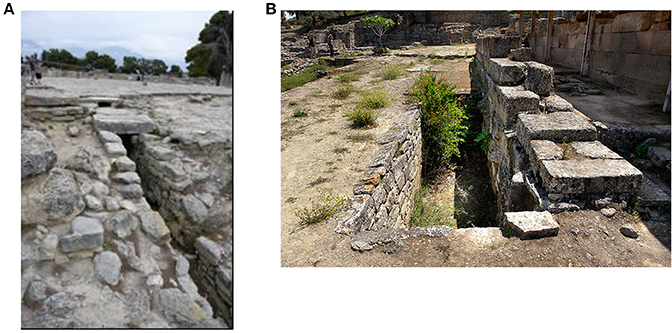
Figure 1. Facilities used for water reuse in prehistoric times (A) water and wastewater conveyance facilities in the palace of Phaistos used to transport water to farmland and (B) cistern in the villa of Hagia Triada used for water storage for subsequent land application purposes.
In the Indus Valley (modern-day Pakistan) similar advanced sewerage and drainage systems have been utilized dating back to ca. 2600 BC (Laureano, 2016). These systems, such as those in the cities of Harappa and Mohenjo-Daro, are important because they made it possible to develop a thriving civilization in Indus Valley (Jones, 1967). In the city of Harappa, every house was connected to the main sewer ensuring the proper removal of the wastes. To insure that the system functioned properly maintenance, inspection holes were provided (Gray, 1940). Local drains were covered and connected to larger sewers used to transport the collected wastewaters for disposal to agricultural lands. Use of human and other wastes for aquaculture was also practiced as early as ca. 1100 BC in various regions in China during the Yin dynasty.
Although lost to history, it is reasonable to assume that the utilization of human waste as fertilizer evolved from observations of enhanced plant growth where animal and human wastes had been deposited either on or below the ground surface. Similar observations must have led to the use of human and animal wastes for aquaculture. As permanent settlements developed, wastewater collection systems evolved out of necessity of removing human and other accumulated wastes. Based on observations of flowing water, the first wastewater collection facilities were open channels, which evolved into channels covered with flat stones (Figure 1A) and subsequently into closed conduits.
Historical Times (ca. 1000 BC−330 AD)
Early in Classical times, the Ionian philosophers recognized that all fresh water in the planet is recycled and reused. Their studies, and especially those of Anaximander (ca. 610–547 BC), on the meteorological phenomena enabled them to identify hydrological processes and broadly speaking the essence of water recycling (Paranychianakis et al., 2015). He reported that rains are generated from the evaporation (atmis) that is sent up from the earth toward under the sun (Hippolytus, Ref. I6, 1-7-D.559 W.10). Later, Aristotle (384–322 BC) understood the water phase change and the energy exchange required for this: …the sun causes the moisture to rise; this is similar to what happens when water is heated by fire (Meteorologica, II.2, 355a 15). He also recognized the water mass conservation by reporting that: Even if the same amount of water does not come back every year and in a given place, yet in a certain period all quantity that has been abstracted is returned (Meteorologica, II.2, 355a 26) (Koutsoyiannis and Angelakis, 2003).
Ancient Greeks were among the first to use wastewater in agriculture (Tolle-Kastenbein, 2005). In Greece, during the Classical period, wastewater originating from the public toilets and residences, along with stormwater, were removed through combined sewer and drainage systems in alley's or on side streets between houses. Archaeologists have found a sewerage and drainage system southeast of the Acropolis consisting of a central sewer which conveyed, by clay drainpipe, wastewater from surrounding houses and workshops (Figure 2A). Also, the great drain in the ancient Agora in Athens delivered rainwater and wastewater to a collection basin (see Figure 2B) (Antoniou, 2010). From that basin, stormwater and wastewater were conveyed through brick-lined conduits to the agricultural fields located in the area known today as Elaionas where it was used to fertilize and irrigated orchards and field crops (Schladweiler, 2002; Yannopoulos et al., 2015). A similar system was found in the hill of Pnyx, where a series of drains were uncovered during archeological excavations (Kalavrouziotis et al., 2015).
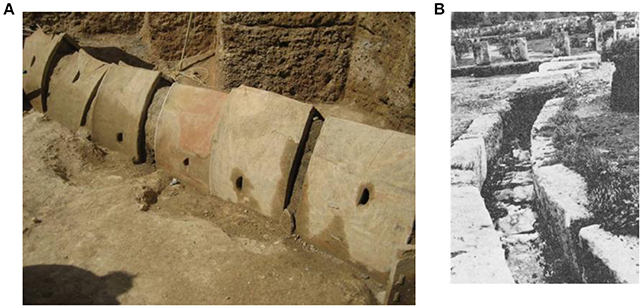
Figure 2. Sewers and drains in ancient Athens used to collect and convey wastewater to central sewer: (A) Clay drain, downhill of Acropolis (with permission of G. Antoniou) and (B) the great drain in ancient Agora (with permission of N. Mamassis).
The disposal sites for the wastes conveyed by the sewer and drainage systems were located downhill in agricultural lands. In addition, sewage and mainly the rainwater from Acropolis was led through an extensive drainage and sewerage system, to the south-east side of the hill where it was possibly reused in the workshops (Kollyropoulos et al., 2015). As noted previously, the beneficial effects of using human waste for fertilizer had been known since the Bronze Age.
Another water reuse example comes from ancient Greece (Hellenic Ministry of Culture Archaeological Receipts Funds, 2007). From the fifth century BC, cisterns were used to feed an extensive network of irrigation channels (Figure 3A). Many of these small cisterns (“pre-cistern,” Figure 3B), were used as a settling basin before discharging to the large cisterns. In addition, various engineering projects are preserved, such as the building of dams on streams, waterproofing of natural depressions, indicative of the efforts made by engineers to make possible the collection of water, and reuse it efficiently to adjacent mines and, probably, to crops. Rainwater from Dionysus theater was also collected to the cisterns from where it was used in the downhill workshops (in the area where the Acropolis Museum is located).
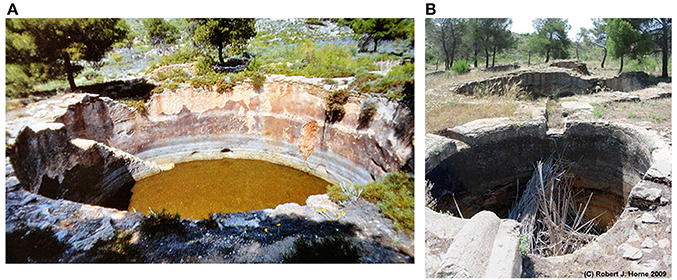
Figure 3. Water cisterns used for water storage and treatment: (A) Cistern for collecting and storing rainwater and (B) a pre-cistern located ahead of the main cistern used to settle out large debris (Tzanakakis et al., 2014).
During the Roman period (ca. 100 BC−330 AD), the physical scale of the sanitation technologies increased significantly. For example, large sewers, of which the Cloaca Maxima is the best known, were used for the removal of surface and underground waters from urban areas. They were not designed to serve as sewers as the Minoans and Indus civilizations had done in the past (ca. 2000 years before, Gray, 1940). With exception some connections in Rome, they were not expected to received excrements directly. But apparently in Roman cities excrements and other wastes were thrown outside in the streets. As a result, extensive street washing programs for cleaning purpose were implemented. One of the complaints of Frontinus, the Rome Water Commissioner at the time (ca. 100 AD), was that large quantities of the water supply of Rome were being diverted for street washing. On the positive side, the diverted water eventually ended up in the sewers and was used for agricultural irrigation outside the cities (Gray, 1940; Schladweiler, 2002). Also, in Rome, wastewater from a sewer network connected to houses was used for crop irrigation and fertilization (De Feo et al., 2014a,b).
In China and other Asian countries, agricultural use of human waste has been practiced for thousands of years. Semidry night soil (human feces and urine) was used to fertilize fields in ancient times, and the practice continues today (Khouri et al., 1994). Also, it is reported that the town of Shibam, in Yemen, was designed, since the third century AD, to facilitate the use of wastewater for both the irrigation and fertilization of crops in addition to disposal.
Medieval Times (ca. 330–1400 AD)
In Europe during Medieval times, water technology and knowledge made little progress. During this period, the emphasis was on wars rather than on civilization. Sanitation, in the best cases, reverted to the basics, becoming very primitive in most towns. As a result, disease outbreaks were commonplace; epidemics decimated towns and villages. In Europe, during Medieval times at least 25% of the population died due to cholera, plague, and other water born diseases (Schladweiler, 2002). Gradually, as populations expanded, the disposal of human feces became an issue in large cities during the Middle Ages. Waste disposal was for the most part unregulated. For instance, in Paris it was only in 1,530 that a municipal decree required property owners to construct cesspools in each new dwelling (Burian and Edwards, 2002). Generally, each neighborhood and community had a self-interested attitude toward water supply and municipal wastewater services. Citizens were willing to pay for sewers to drain their neighborhood, but only into the next one (Burian and Edwards, 2002). This vision was unfortunately exported to Australia and to the Americas once colonialized.
Although there was turmoil in Europe during medieval times, some innovative ways to reuse water were developed and used in early Central and South America before colonization. The Chinampa is one of these. Chinampas are a Mesoamerican agriculture practice that has been described as floating gardens. Chinampas do not need irrigation and are small but very high productive plots artificially built over wetlands, marshes, shallow lakes, or flood plains using sediments, manure, compost, and vegetation debris (Smith, 1996; Villalonga Gordaliza, 2007). Chinampas are considered to be the most productive and ecologically sustainable form of agriculture in pre-Hispanic Mesoamerica, as they reclaim solid and liquid wastes improving and protecting local biodiversity (Morehar, 2012). The exact origin of Chinampas is not well-known but Aztecs (ca. 1200–1500 AD) were among the first civilizations documenting its use in pyramid paintings. Here again, observation of the benefits of animal and human waste must have played an important role in the development of the Chinampas (Coe, 1964).
Aztecs that lived in the Valley of Mexico were distributed in hundreds of towns and their capital, Tenochtitlan, is where Mexico City is today. The Valley of Mexico had, at that time, seven major lakes and 12,000 ha of wetlands placed southeast where Chinampas were built. Chinampas, together with the local conventional agricultural, made it possible for inhabitants of the valley to be food self-sufficient, even though 1.5–3.0 million inhabitants lived in the valley (McCaa, 2000). In Tenochtitlan, when the Spanish arrived, the population was 250,000 (at that time in Paris and London the population was < 20,000). Chinampas are still used today to feed part of Mexico City's population and are a UNESCO world heritage site. Other Aztec contributions to the management of water were: (a) the joint management of saline water and freshwater according to the water quality use needs; (b) the control of the lake levels to avoid urban floods; and (c) the joint management of urban used water and agriculture to ensure food security (Palerm, 1973).
Water Reuse in Early and Mid-Modern Times (ca. 1400–1900 AD)
Sanitation practices re-emerged in the mid-nineteenth century following the great epidemics in several regions of the world. During that period, authorities recognized the need for sanitation and this led to the development of effluent disposal and reuse practices, known as sewage farms to protect public health and to control water pollution (Stanbridge, 1976; US EPA, 1979). Engineered land application systems evolved from sewage farms during this period. At the same time, in many parts of the Orient, feces and urine separation was practiced.
Development and Implementation of Sewage Farms
The earliest documented application of wastewater to the land for agricultural use, occurred in what were known as “sewage farms,” first in Bunzlau (modern-day Poland), in 1531 and later in Edinburgh (Scotland) in 1650. In both locations, wastewater was used for beneficial crop production (Tzanakakis et al., 2014). With the rapid growth of cities “sewage farms,” involving irrigation and fertilization of agricultural lands, were viewed favorably as an appropriate solution for the disposal of large volumes of wastewater. Large “sewage farms” were established in rapidly growing cities of Europe and the USA at the end of eighteenth century and in Australia in the end of nineteenth century (see Table 1) (Reed et al., 1995; Tzanakakis et al., 2014). As reported in Table 1, some of them are still in use. At the beginning of twentieth century sewage farms in France reached their highest usage in four different areas: Gennevilliers (900 ha), Achères (Achères plain, 1,400 ha), Pierrelaye (2,010 ha), and Triel (950 ha) using raw wastewater supplied by the Colombes pumping station in Paris (Kamizoulis et al., 2003; Jimenez and Asano, 2008; Lazarova et al., 2013).
In Mexico, drainage canals were built around 1890 to collect wastewater from Mexico City and to irrigate and fertilize agricultural lands in the Mezquital Valley. The scheme is now used to irrigate up to 90,000 ha of agricultural cropland and is the largest water reuse scheme in the world. An added benefit has been the recharge of groundwater in the region (Jimenez and Asano, 2008). During the nineteenth and twentieth centuries, many of the cities in Germany implemented sewers which discharged wastewater into a system of ponds and fields for direct recycling through sophisticated agriculture and aquaculture systems (Prein, 1990). In Copenhagen, the Capital of Denmark, the traditional dry sanitation system, linking agriculture with urban areas, was replaced in the early twentieth century by a sewerage and drainage system discharging untreated wastewater and rainwater into the Baltic Sea (Wrisberg, 1996).
History of Separation and Recycling of Urine and Feces
Since the beginning of the twenty-first century, there is renewed interest in developing urine separation systems and a number of systems have been developed and tested. However, it should be noted that the separation of urine from feces at the source is not a new development. It has been practiced for thousands of years in different regions of the world and it is varying from country to country. For example, in China the objective has been to reuse the nutrients present in human excreta for fertilizing agricultural lands. Similarly, urine was separated and collected in simple toilets as described by Antoniou et al. (2016). In other regions of the world, the main purpose for separation of urine has been to obtain a dry, manageable and hygienic fecal fraction. For example, in Yemen, with warm climate, urine is separated in simple toilets and allowed to trickle down onto an outside wall of buildings where it quickly evaporates (Johansson et al., 2000). Also, in Shibam, Yemen, toilets had two outlets; one in front and the other in the back for separating the urine from the feces since ca. 750 AD (Laureano, 2016).
In Korea, the separation of feces and urine has been practiced for more than 600 years, during the Joseon dynasty (1392–1910). The feces and urine were used as fertilizers, to minimize the pollutant loads discharged in the environment. Different containers were used for each waste, e.g., urine jars which were usually situated nearby rooms for easier access. The collected urine and other wastes were fermented to serve as agricultural fertilizers. The different fermentation stages of urine were made possible through the use of several urine jars, which were stored in an organized method (Han and Kim, 2014). The containers for feces and urine called ojum-janggun and ddung-janggun were used to carry separated urine and feces are illustrated in Figure 4.
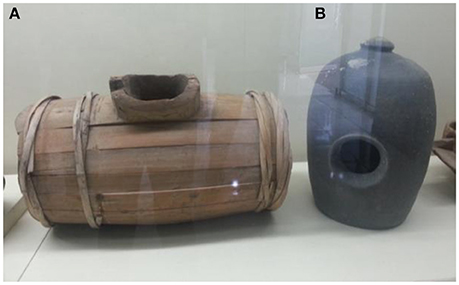
Figure 4. Containers used for the storage of feces (A) and urine (B) called: ojum-janggun and ddung-janggun, respectively, exhibited at Goyang exhibition hall for sanitation in Gyeonggi-Do, Korea (with permission of M. Han).
In Danish and Swedish cities urine-separating toilets were used for hygienic reasons since the middle of nineteenth century. Their design was very similar to the toilets used today. Because most of the nutrients in household wastewater and biodegradable solid waste are present in urine, its separation contributed not only to solving hygienic problems but also to a decrease in the emission of eutrophication agents and an increase in their reuse (Antoniou et al., 2016). However, the use of urine separation toilets diminished early in the twentieth century.
Engineered Wastewater Treatment Systems
The development of modern methods of sewage treatment can be traced back to the mid nineteenth century in England and Germany. The large population in London and the limited area available for treatment in sewage farms, broad irrigation, or intermittent filtration led to renewed interest in more intensive methods of treatment before discharging the treated effluent to land and hence to freshwater bodies. Methods of treatment that were used included large septic tanks, contact beds, and trickling filters. Where sufficient land was available intermittent sand filters were also used.
Water Reuse in Contemporary Times (1900 AD-Present)
The advent of twentieth century brought significant technological and scientific innovations along with a significant growth in the implementation of wastewater treatment plants (WWTPs) that could handle large volumes of wastewater for direct discharge to waterways and the ocean. These plants were adopted widely by most of the major urban centers around the globe, as they were compact and did not require large areas for treatment compared to sewage farms (Metcalf and Eddy Inc., 1991; Jimenez and Asano, 2008; Lazarova et al., 2013). However, with the construction of mechanized WWTPs and discharge to rivers or the ocean, interest of reclaiming nutrients and organic matter to fertilize and improve soil characteristics diminished. In the latter part of the twentieth century and the first part of the twenty-first century, water reclamation and reuse has regained popularity because of population growth, urbanization, the growth of megacities, climate change, the increasing need for water in a variety of applications, and because of the development of water reclamation technologies able to produce water of almost any quality desired including water of quality equal to or higher than drinking water.
The purpose of this section is to consider modern water reuse practice. Subjects considered include: (a) the importance of modern technology, (b) changing views of water reclamation and reuse; (c) water reuse applications; (d) review other non-domestic sources of wastewater for reuse; (e) understanding and quantifying unplanned potable reuse, (f) health and environmental issues; and (g) review development of water reuse criteria. Emerging trends in water reuse and future challenges in water reuse are considered in the following two sections, respectively.
Importance of Modern Technology
Some important technological developments that have brought about the renewed interest in wastewater reclamation include: the availability of reliable microfiltration, ultra filtration, and reverse osmosis membranes; the use of ozone coupled with biological filtration, low, medium, and high energy UV disinfection; high energy UV advanced oxidation. These treatment processes, can now be used to remove acute toxicity (e.g., microorganisms) and chronic toxicity (e.g., chemical constituents). Further, because multiple treatment processes are now available for any given constituent, the multiple barrier concept, which involves the use of redundant treatment processes or other activities, in parallel or series, is applied to reduce the risk from a given constituent (e.g., pathogenic microorganisms). In addition, instrumentation and monitoring equipment have also contributed to the reliability of advanced water treatment facilities.
Changing Views of Water Reclamation and Reuse
Many things have changed in the water reclamation and reuse field in the contemporary period (1900 AD-present), but especially so during the last three decades. One of the most relevant changes is the recognition of the importance of reclaimed water in an integrated water resources management plan. Reclaimed water has become a new, additional, alternative, reliable water supply source right at the doorstep of metropolis for numerous uses in the diverse environment. This approach has even been recognized by the United Nations through the World Water Development Report 2017 (UNESCO, 2017) focusing on wastewater as a resource. Moreover, successful stories on water reuse have expanded the frontier from agricultural and landscape irrigation and restricted urban uses to a variety of uses including potable reuse (Crook, 2010; Mujeriego, 2013; Tchobanoglous et al., 2014).
Water Reuse Applications
Historically, agricultural irrigation has been and continues to be the largest use of untreated wastewater. Early on, direct irrigation was used. Sewage farms were developed as the quantity of wastewater increased. Subsequently, more intense forms of wastewater treatment were developed to deal with the ever-increasing quantities of wastewater to protect the environment. With the intensification of wastewater treatment processes, the quality of the effluent improved, which made reclaimed water suitable for a greater variety of agricultural applications. The development of more restrictive effluent discharge standards in the United States has led to further improvement in effluent quality, making the use of reclaimed water suitable for a variety of different applications. Health protection, as discussed subsequently, initially centered on microbiological quality, has expanded to a wider and more comprehensive view of chemical quality, particularly in association to “emerging” contaminants which are of key importance for potable reuse.
Water Reuse Categories
The principal water reuse categories are summarized in Table 2. The reuse categories in Table 2 are also ranked in relative order of total usage, as practiced in the United States. Agricultural and landscape irrigation has expanded from earlier restricted uses to unrestricted irrigation of food crops eaten raw, when wastewater has been treated properly. With improved effluent water quality, there has been a global trend to diversify water reuse practices beyond agricultural and landscape irrigation, to recreational and environmental use, industrial reuse, groundwater recharge and potable reuse (IPR and DPR, respectively) (Zhang et al., 2017). Potable reuse is considered in the following section.
Religious Concerns in Islamic Countries
To address religious concerns in some Islamic countries, Fatwas (legal ruling on an issue of religious importance) have been issued in Saudi Arabia, Oman, and in the UAE (CLIS, 1978). It should be noted that in these fatwas, sewage may be used for irrigation resulted that the impurities present in the raw wastewater are removed. One example of a water reuse project studied in an Islamic society is the United States Agency for International Development's (US AID) Reuse in Industry, Agriculture and Landscaping (RIAL) project in Jordan. In this project, farmers have been engaged in the beneficial use of treated wastewater in agriculture. Such projects have been successful because they have addressed not only technical and economic, but also institutional and cultural issues (US AID, 2008). The RIAL projects led to the development of the first Water User Association in Jordan for the operation, maintenance, and management of treated wastewater-based irrigation systems and the introduction of the use urban wastewater effluent for the first time in this country.
Other Non-domestic Water Sources for Reclamation and Reuse
Historically, wastewater, derived from wastewater collection systems, has been the principal source reclaimed water. However, population growth and urbanization combined with limited reliable water resources have also contributed to the consideration of a wider range of potential water sources for reclamation and reuse. Other potential sources of wastewater for reclamation and reuse are identified in Table 3. Many of the potential water sources, identified in Table 3, are most suitable for decentralized wastewater management systems (see subsequent discussion). For example, in the late 1970's, a complete onsite wastewater recycling system was developed to produce drinking water. A number of these systems were installed at individual homes in Colorado (USA), during the period from 1976 through 1982 (Tchobanoglous et al., 2011).
Understanding and Quantifying Unplanned Potable Reuse
It is estimated that over 80% of the world's wastewater and over 95% in some under developing countries is released to the environment without treatment. Typically, untreated wastewater is either discharged to rivers or streams where it is diluted and transported downstream or infiltrated into aquifers, where the constituents in raw wastewater can impact freshwater supplies (UNESCO, 2017).
The downstream use of a water source, for drinking water, that is subject to upstream wastewater discharges is referred to as unplanned potable reuse (also known as de facto potable reuse). In some cases, reclaimed water represents a significant portion of the total flow in many receiving waters. Some notable examples include the Santa Ana River in southern California; the Platte River downstream from the City of Denver, Colorado; the Ohio River near the City of Cincinnati, Ohio; and the Occoquan Watershed located southwest of Washington, DC, as well as many major rivers in Europe. In some drinking water treatment plants, especially under low-flow conditions, a large fraction (up to 75%) originated as wastewater effluent from upstream communities (Dalezios et al., 2018). As the world's population continues to grow, and greater stress is placed on water supplies, understanding the extent and implications of unplanned (de facto) PR on the design of water treatment plants will be important in protecting public health.
In addition to discharges to rivers, numerous cases have been documented where untreated wastewater applied to land for agricultural use has resulted in unplanned recharge of groundwater aquifers, from which water is withdrawn for human consumption. Locations where such unplanned groundwater recharge has occurred include Egypt, Mexico, Peru, and Thailand. In Mexico, a large flow of wastewater from Mexico City is discharged to the arid Tula Valley (also known as the Mezquital Valley) where a total of 500,000 inhabitants are supplied water this way (Jimenez and Asano, 2008). Recently, a study has been completed in which the degree of unplanned agricultural water reuse in selected EU river basins in Spain, Italy, and France has been documented. This study is considered a first quantitative attempt to estimate the degree of de facto reuse in European river basins, showing a wide range of impacts from discharged wastewater among the river basins; also, varying with season Drewes et al. (2017).
Health and Environmental Issues
While there is no reliable epidemiological evidence that the use of reclaimed water for any of its applications (see Table 1) has caused a disease outbreak in the USA, potential transmission of infectious disease by pathogenic organisms is the principal concern in water reclamation and reuse. This concern is true particularly in developing countries where untreated or inadequately treated wastewater is used widely (Angelakis and Rose, 2014). In addition, the production, distribution, and use of reclaimed water that is regulated inadequately may result in adverse environmental impacts.
Sources of Constituents of Concern in Water Reuse
Health and environmental issues associated with water reclamation and reuse are related to wastewater treatment, reclaimed water quality, chemical and microbiological constituents that may be present in the reclaimed water, health risk assessment, and public perception and acceptance. Reclaimed water derived from municipal wastewater comes from a variety of sources including households, schools, offices, hospitals, and commercial and industrial facilities. Thus, untreated municipal wastewater typically contains a variety of biological and chemical constituents that may be hazardous to human health and the environment. In many developing countries, the irrigation of vegetable crops with untreated or inadequately treated wastewater is a major source of enteric diseases and other waterborne diseases. The situation is different, however, in the United States and other industrialized countries where reliable wastewater treatment and health-related water reclamation and reuse criteria and regulations dictate the feasibility and acceptability of water reuse.
Development of Water Reuse Criteria, Guidelines, and Regulations
Historically, as noted previously, water reuse evolved from observation, necessity, and opportunity. These factors remain the same for the contemporary period (1900-present). Although agricultural irrigation with low quality wastewater was practiced in some areas of Europe as well as the United States in the late 1800s, there were no significant criteria or restrictions on the practice until the early part of the twentieth century. As urban areas began to encroach on sewage farms and as the scientific basis of disease became understood more widely, concern about the health risks associated with irrigation using wastewater grew among public health officials. Public health concerns led to the establishment of regulations and/or guidelines for the use of reclaimed water for agricultural irrigation, which was the first reclaimed water application to be regulated (Paranychianakis et al., 2015). Subsequently, regulations have been developed for a variety of water reuse applications.
The timeline of water reuse criteria and regulations is shown in Table 4. Establishing criteria for water reuse is a challenge because of the absence of comprehensive international regulations and/or guidelines, and of a scientific consensus on the approach that should be adopted to issue such criteria. Existing guidelines and/or regulations are typically based on treating wastewater to control negative impacts on man and the environment rather than focusing on the opportunities for promoting its reuse. The research priorities should be directed toward the development of new criteria and regulations that will enhance the beneficial reuse of all types wastewater.
Emerging Trends in Water Reuse
It is estimated that by 2050 the world population will increase by an additional 2 billion people (e.g., a city of about 145,000 every day) (Reiter, 2012). This population growth—coupled with industrialization and urbanization—will result in an increasing demand for water and will have serious consequences on the environment. Wastewater treatment and reuse will play a vital role in future urban planning. Although there will be many different approaches to dealing with future population growth, three major trends with respect to water reuse stand out: (a) potable reuse (PR), (b) integrated wastewater management (IWM), and (c) integrated water and wastewater management.
Potable Reuse
Perhaps the most important future trend in the field of water reuse, especially in large metropolitan areas, is PR. As the name implies, PR involves the reuse of wastewater for human consumption following various treatment interventions. Today, wastewater is no longer viewed as a waste requiring disposal, but as a renewable recoverable source of drinking water, resources, and energy (Tchobanoglous, 2012). The purpose here is to introduce PR and to highlight some of the issued involved. Because the body of literature related to PR has increased dramatically, the following reports, all available on the internet, are recommended (Tchobanoglous et al., 2011, 2015; Mosher et al., 2016; NWRI, 2016; Sharvelle et al., 2017). It should be noted that the US EPA acknowledged the importance of and highlighted the increased interest in pursuing potable water reuse, in its recently issued 2017 Potable Reuse Compendium (US EPA and CDM Smith, 2017) as a supplement the previously published Guidelines for Water Reuse (US EPA/USAID, 1992; US EPA, 2004, 2012).
Definitions and Terminology for Potable Reuse
When discussing PR, one of the problems is terminology. Water reuse definitions and terminology in common use in the literature and newly adopted terminology in California are reported in Table 5. While the meanings are essentially the same, the abbreviations are not. Hopefully, this situation will be corrected in the future. As reported in Table 5, there are two types of planned PR: (a) indirect potable reuse (IPR), and (b) direct potable reuse (DPR). The two different types of PR are illustrated in Figure 5. In IPR (see Figure 5A), advanced treated water is introduced into an environmental buffer (e.g., groundwater aquifer or surface water body) to assure the safety of the advanced treated water by providing sufficient retention time and to lose its identity by blending with other local water before being withdrawn for potable reuse.
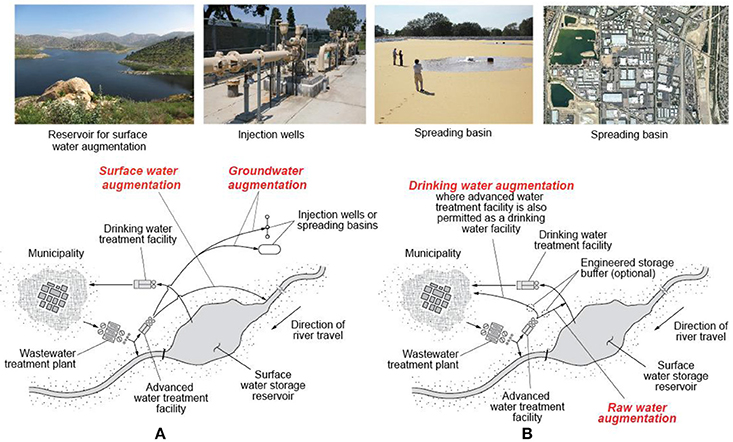
Figure 5. Pictorial view of alternative forms of PR: (A) indirect PR and (B) direct PR (from Tchobanoglous, 2017).
In DPR (see Figure 5B), advanced treated water is used to augment a raw water supply by blending with other water before the combined stream is treated in a drinking water treatment plant. If the advanced water treatment facility is also permitted as a drinking water plant, finished water could potentially be introduced directly into the potable water distribution system. In DPR, the optional engineered storage buffer (ESB) may be used to: (a) provide a water storage containment facility of sufficient volumetric capacity to retain ATW for a specified period of time until process or system corrections can be made, if there is a plant failure; (b) prevent blending of ATW that does not meet water quality standards with other sources of raw water; and (c) to prevent the addition of finished ATW that does not meet water quality standards to the drinking water distribution system (Tchobanoglous et al., 2011). Representative examples of each type of potable reuse are described in Table 6.
Issues in PR
The principal concerns with PR are related to public health. More specifically, acute toxicity related to pathogenic microorganisms (i.e., enteric virus, Giardia, and Cryptosporidium) and chronic toxicity related to known and unknown chemical constituents found in wastewater. Extensive research has been conducted on the methods and technologies that can be implemented to protect public health. Based on the available technologies and operating strategies, public health protection can be assured. It is certain that new and improved treatment technologies will continue to be developed. The biggest challenge will be to assess whether constituents identified at extremely low concentration, using new and improved analytical techniques, are of any health concern.
Integrated Wastewater Management
In most wastewater collection and treatment systems, wastewater is transported through the collection sewers to a centralized WWTP at the downstream end of the collection system near to the point of dispersal to the environment. Because centralized WWTPs are generally arranged to route wastewater to these remote locations for treatment, water reuse in urban areas is often limited by the lack of dual distribution systems (Tchobanoglous et al., 2014). The infrastructure cost for storing and transporting treated water to the point(s) of use are often prohibitive, rendering reuse uneconomic. Thus, in the future urbanized world, greater use will be made of decentralized wastewater management systems which can be implemented at or near the point(s) of waste generation and reuse.
An alternative to the conventional approach of transporting reclaimed water from a central WWTP is the concept of decentralized (satellite) treatment at upstream locations with localized reuse and/or the recovery of wastewater solids. A pictorial view of an IWM system is illustrated in Figure 6. Along with decentralized treatment and PR, sewer mining (removal of wastewater to a large collection system for local treatment and reuse with solids processed at a central or regional WWTP) as shown on Figure 6 is also an integral feature of IWM. Two of the largest decentralized wastewater management systems in the United States are operated by the City of Los Angeles and the County Sanitation Districts of Los Angeles County.
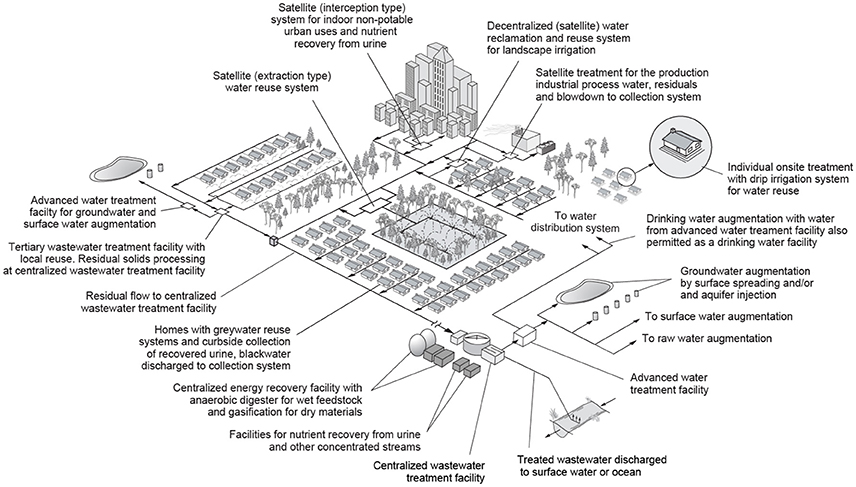
Figure 6. Schematic view of an integrated wastewater management system (adapted from Gikas and Tchobanoglous, 2009).
Integrated Water and Wastewater Management
Another trend in the environmental engineering and water resources field is the use of the term one water to describe all forms of water. The implications of the one water concept for municipalities would be to merge, what are now typically, individual water and wastewater departments, into one department. By merging the two departments it is reasoned that more thoughtful, rational and cost-effective solutions can be developed to meet future water needs.
Future Issues and Challenges
In the next decade, a number of issues and challenges will need to be resolved to optimize water reclamation and reuse. Important issues include (a) how to couple advanced wastewater treatment facilities with seawater desalination facilities, (b) the development of more effective techniques and methods incorporating risk assessment to assess human and environmental health effects of wastewater constituents, and (c) the development of appropriate water reclamation and reuse regulations, applicable to many different situations, that both help to promote reuse as well as regulate it. Further, based on recent studies it was found that users of recycled water are mainly interested in the quality rather than in the origin of water (Paranychianakis et al., 2015).
Coupling Advanced Wastewater Treatment With Desalination
In megacities, located on or near coastal areas, the opportunity to couple advanced wastewater treatment facilities with seawater desalination facilities will offer additional opportunities for PR. Operationally, the effluent from the advanced treatment facility would be combined with desalinated water and treated in a membrane type water treatment plant permitted as a drinking water plant. Because both water sources are of high quality, the combined flow would be easy to treat. The advantage this scheme offers is that drinking water could be used locally, thus avoiding the need for environmental buffers (e.g., groundwater or surface water) and long pipelines to deliver dilution water.
Another approach that has been used is to integrate seawater desalination and advanced wastewater treatment facilities to produce high quality water for industrial uses. Typically, brine from the advanced wastewater treatment facility is blended with seawater and desalinated. Use of water produced in this integrated approach increases the amount of water available for potable and other uses. In Japan, as well as Singapore, high quality water from advanced wastewater treatment facilities is used in industrial applications.
Incorporating Risk Assessment in Evaluating Human Health Effects of Wastewater Constituents
An integrated approach is needed that combines risk assessment and risk management of water related diseases as well as health effects of chemicals and unknowns. The WHO provided a framework for the development of health-based criteria for water- and sanitation related microbial hazards as well as illness resulting from water related exposure to toxic chemicals (Fewtrell and Bartram, 2001). This approach facilitates the management of disease in an integrated, holistic fashion and not in isolation from other disease or exposure routes. Disease outcomes from different exposure routes can be compared by using a common metric, such as disability adjusted life years (DALYs). For carcinogenic chemicals in drinking water, WHO guideline values have been set at a 10−5 upper excess risk which is also about 1 × 10−6 DALY (1 μDALY) per person per year (WHO, 2004). These guidelines were extended in 2017 to cover PR (WHO, 2017). Australia was the first country to develop national water quality guidelines specifically for drinking water augmentation. These guidelines incorporated WHO guidelines and were applied to PR schemes in Brisbane, Queensland, Perth, and Western Australia (Law, 2016). Recently, the guidelines have been followed-up with the development of detailed protocols for the validation of treatment performance for a number of key advanced water treatment processes (Khan and Anderson, 2018). However, worldwide, the application of the risk assessment approach remains limited.
Develop Appropriate Water Reuse Policies, Criteria, and Regulations to Protect Health and the Environment
Although a large variety of water reuse criteria exists there is little standardization throughout the world. Efforts for more consistency among different international regulations and/or guidelines related to water quality should be fostered. At the same time, efforts should be made to align legislation produced to protect the environment in a way which allows effective water reuse. For the sake of integrated water management and to gain public understanding and acceptance, water reuse criteria should be part of a set of consistent water regulations applying to all forms of water reuse.
What is needed is the development of comprehensive, flexible, and efficient regulatory framework based on a realistic risk assessment. In some cases (e.g., EU-Mediterranean States), the existing national regulations for recycled water need to be updated considering new knowledge to address in a realistic way the potential risks arising from pathogens and trace organics to encourage water reuse by avoiding unnecessarily restrictive regulations (Paranychianakis et al., 2015). The possibility of establishing criteria by water use category independently of the water source or origin (e.g., one water concept) has been proposed by Paranychianakis et al. (2015). In this context, it is also important to keep in mind difference between developing and developed countries. Initially, a step by step approach is advisable in which improving current risk situation is better than having over restricted not enforceable legislations.
Conclusions
Starting from the historical tradition of land disposal and irrigation, water reuse has evolved into a myriad of applications, with PR representing one of the last frontiers. As in historical times, the modern practice of water reuse has evolved through observation, necessity, and opportunity. The development of megacities has rendered the traditional concept and use of a single WWTP for all wastewater untenable; also, limiting reuse applications. Decentralization is a necessity which is inevitable. However, with decentralization will come many more opportunities for local water reuse. New technologies that are now being implemented as well as those under development will usher in a new day in conventional and advanced wastewater treatment. Combining advanced treated water with desalinated water will be an attractive option in megacities. New scientific breakthroughs will lead to enhanced understanding of the significance of criteria found in both water and wastewater and their significance to human health. New regulations will be needed to reflect this enhanced biological and chemical understanding. To meet future water resource management and water reuse challenges effectively, cities must embrace the one water concept.
Author Contributions
All of the authors contributed collaboratively to the preparation of the final version of the manuscript.
Conflict of Interest Statement
The authors declare that the research was conducted in the absence of any commercial or financial relationships that could be construed as a potential conflict of interest.
Acknowledgments
A portion of the material presented in this paper was presented in the 2nd IWA Regional Symposium on World's Water Resources: Past, Present and Future, held on 22–24 March, 2017 in Çesme-Izmir, Turkey.
Critical and constructive comments offered by John. Anderson, Afton Water, 1 Cumbora Cct, Berowra, NSW 2081, Australia and Dr. Valentina Lazarova, SUEZ Environment, 78230 Le Pecq, France are gratefully acknowledged.
References
Aertgeerts, R., and Angelakis, A. N. (2003). State of the Art Report: Health Risks in Aquifer Recharge Using Reclaimed Water. WHO, Water, Sanitation and Health Protection and the Human Environment. Copenhagen: WHO, Geneva and WHO Regional Office for Europe.
Alcalde-Sanz, L., and Gawlik, B. M. (2017). Minimum Quality Requirements for Water Reuse in Agricultural Irrigation and Aquifer Recharge: Towards a Water Reuse Regulatory Instrument at EU Level. Ispra: EC – Joint Research Centre.
Angelakis, A. N., and Rose, J. (eds.). (2014). Evolution of Sanitation and Wastewater Management through the Centuries. London: IWA Publishing.
Angelakis, A. N., and Spyridakis, S. V. (1996). “Wastewater management in Minoan times,” in Proceedings of the Meeting on Protection and Restoration of Environment (Chania), 549–558.
Angelakis, A. N., Asano, T., and Bahri, A. (2017). “A Brief History of Water Reuse. 2nd IWA Regional Symposium on World's Water Resources: Past, Present and Future,” in Draft Proceedings of the Symposium Book, eds A. Baba, O. Gunduz, and G. Tayfur (Izmir: Izmir Institute of Techn), 154–165.
Antoniou, G. P. (2010). “Ancient Greek lavatories. Operation with reused water,” in Ancient Water Technologies, ed L. Mays (London; New York, NY: Springer), 67–86.
Antoniou, G., De Feo, G., Fardin, F., Tamburrino Tavantzis, A., Khan, S., Fie, T., et al. (2016). Evolution of toilets worldwide through the millennia. Sustainability 8:779. doi: 10.3390/su8080779
Asano, T., and Cotruvo, J. A. (2004). Groundwater recharge with reclaimed municipal wastewater: health and regulatory considerations. Water Res. 38, 1941–1951. doi: 10.1016/j.watres.2004.01.023
Asano, T., and Levine, A. D. (1996). Wastewater reclamation, recycling and reuse; past, present, and future. Water Sci. Technol. 33, 1–14. doi: 10.1061/40644(2002)284
Burian, S. J., and Edwards, F. G. (2002). “Historical perspectives of urban drainage,” in Proceedings of 9th International Conf. on Urban Drainage, ASCE (Portland, OR).
California State Board of Health (1918). Regulations Governing Use of Sewage for Irrigation Purposes. Sacramento, CA: California State Board of Health.
CDPH (California Department of Public Health) (2014). Regulations Related to Recycled Water, June 18, 2014 (Revisions Effective on 6/18/14). Sacramento, CA: CDPH.
CITAI (Comitato Interministeriale per la Tutela delle Acque dall'Inquinamento) (1977). Norme Tecniche Generali per la Regolamentazione Dello Smaltimento dei Liquami sul Suolo, Anche Adibito ad usi Agricoli, Purch'e le Immissioni Siano Direttamente Utili Alla Produzione, e Nel Sottosuolo, Esclusi i Casi Nei Quali Possono Essere Danneggiate le Falde Acquifere. Allegato 5 alla Delibera. CITAI 4 febbraio 1977, G.U. 21 febbraio 1977, n. 48, Italy.
CLIS (Council of Leading Islamic Scholars) (1978). Judgement regarding purifying wastewater: judgement no. 64 on 25 Shawwal, 1398 ah Thirteenth meeting of the Council of Leading Islamic Scholars during the second half of the Arabic month of Shawwal, 1398 ah (1998), Taif. J. Islamic Res. 17, 40–41.
Coe, M. D. (1964). The chinampas of Mexico. Sci. Amer. 211, 90–99. doi: 10.1038/scientificamerican0764-90
Cotruvo, J., Bridgers, D., Cairns, W., Jiménez Cisneros, B., Cunliffe, D., Davidson, D., et al. (2013). Water Recovery and Reuse: Guideline for Safe Application of Water Conservation Methods in Beverage Production and Food Processing. Washington, DC: A Publication of the ILSI Research Foundation. Available online at: http://ilsi.org/wp-content/uploads/2016/05/Guideline-for-Water-ReUse-in-Beverage-Production-and-Food-Processing.pdf
Crook, J. (2010). Regulatory Aspects of Direct Potable Reuse in California. Fountain Valley, CA: National Water Research Institute, Project Number 09-KM-007. Available online at: http://nwri-usa.org/pdfs/NWRIPaperDirectPotableReuse2010.pdf
Dalezios, N., Angelakis, A. N., and Eslamian, S. (2018). Methodological framework for holistic water scarcity management. Int. J. Hydrol. Sci. Technol. 17, 1–40. doi: 10.1504/IJGENVI.2018.090629
De Feo, G., Antoniou, G., Fardin, H. F., El-Gohary, F., Zheng, X. Y., Butler, D., et al. (2014a). History of sanitary sewers worldwide. Sustainability 6, 3936–3974. doi: 10.3390/su6063936
De Feo, G., Antoniou, G. P., Mays, L., Dragoni, W., Fardin, H. F., El-Gohary, F., et al. (2014b). “Chapter 9: Historical development of waste water management,” in Handbook of Engineering Hydrology, Vol. 2, ed S. Eslamian (Boca Raton, FL: Taylor and Francis Group), 163–217.
Drewes, J. E., Hübner, U., Zhiteneva, V., and Karakurt, S. (2017). Characterization of Unplanned Water Reuse in the EU. Garching: Technical Univ. of Munich. (prepared for the European Commission DG Environment), 60.
FAO (1985). “Water quality for agriculture,” in FAO Irrigation and Drainage Paper 29 (Rev. 1), eds R. S. Ayers and D. W. Westcot (Rome: Food and Agriculture Organization of the United Nations).
Feachem, R. G., Bradley, D. J., Garelick, H., and Mara, D. D. (1983). Sanitation and Disease-Health Aspects of Excreta and Wastewater Management. World Bank Studies in Water Supply and Sanitation 3. Chichester: John Wiley and Sons.
Fewtrell, L., and Bartram, J. (eds.). (2001). Water Quality: Guidelines, Standards and Health – Assessment of Risk and Risk Management for Water-related Infectious Disease. London: IWA Publishing.
Fine, P., Halperin, R., and Hadas, E. (2006). Economic considerations for wastewater upgrading alternatives: an Israeli test case. J. Environ. Manag. 78, 163–169. doi: 10.1016/j.jenvman.2005.04.014
Gikas, P., and Tchobanoglous, G. (2009). The role of decentralized strategies in water resources management. J. Environ. Manag. 90, 144–152. doi: 10.1016/j.jenvman.2007.08.016
Guidelines for Integrated Water Resources Development and Management in India (2016). Ministry of Water Resources, River Development and Ganga Rejuvenation, Central Water Commission, Basin Planning and Management Organization, Government of India (New Delhi).
Guidelines for Series of Standard on Water Reuse in China (2008). Guidelines for Series of Standard on Water Reuse. Beijing: Standards Press of China.
Han, M., and Kim, M. (2014). “Chapter 14: Revisiting the technical and social aspects of wastewater management in ancient Korea,” in Evolution of Sanitation and Wastewater Management Through the Centuries, eds A. Angelakis and J. Rose (London: IWA Publishing), 301–312.
Hellenic Ministry of Culture and Archaeological Receipts Funds (2007). Lavreotiki the Lavrion Museum. Lavrio: Archeological Receipts Fund, Publications Department (in Greek).
Hellenic Ministry of EnvironmentEnergy and Climate Change. (2011). Common Ministerial Decision No 145116 (354B)/08.03.11. Athens: Measures, Limits and Procedures for Reuse of Treated Wastewater. Ministry of Environment, Energy and Climate Change (in Greek).
INNORPI (Institut National de la Normalisation et de la Propriété Industrielle) (1989). Environment Protection – Use of Reclaimed Water for Agricultural Purposes – Physical, Chemical and Biological Specifications (in French), Tunisian standards. INNORPI.
ISO 16075-3 (2015). ISO Guidelines for Treated Wastewater Use for Irrigation Projects - Part 3: Components of a Reuse Project for Irrigation. Available online at: http://www.iso.org/iso/home/store/catalogue_tc/catalogue_detail.htm?csnumber=62759
Jiménez, B. (2005). Treatment technology and standards for agricultural wastewater reuse: a case study in Mexico. J. Irrig. Drain 54, 23–33. doi: 10.1002/ird.183
Jimenez, B., and Asano, T. (eds.). (2008). Water Reuse: International Survey of Current Practice, Issues and Needs, Scientific and Technical Report No. 20. London: IWA Publishing.
Johansson, M., Jönsson, H., Höglund, C., Stintzing, A. R., and Rodhe, L. (2000). Urine Separation—Closing the Nutrient Cycle. Stockholm: HSB National Federation.
Kalavrouziotis, I. K., Koukoulakis, P. H., and Drakatos, P. A. (2015). Water and wastewater management in antiquity in the context of an ethically oriented environmental protectionInt. J. Glob. Environ. Issues 14, 226–237. doi: 10.1504/IJGENVI.2015.071847
Kamizoulis, G., Bahri, A., Brissaud, F., and Angelakis, A. N. (2003). Wastewater Recycling and Reuse Practices in Mediterranean Region: Recommended Guidelines. Available online at: http://www.a-angelakis.gr/files/pubrep/recycling_med.pdf
Khan, J. S., and Anderson, R. (2018). Potable reuse: experiences in Australia. Curr. Opin. Environ. Sci. Health 2, 55–60. doi: 10.1016/j.coesh.2018.02.002
Khouri, N., Kalbermatten, J. M., and Bartone, C. R. (1994). Reuse of Wastewater in Agriculture: A Guide for Planners. Washington, DC: The International Bank for Reconstruction and Development/The World Bank (Accessed July 29, 2016).
Kollyropoulos, K., Antoniou, G., Kalavrouziotis, I., Krasilnikoff, J., Koutsoyiannis, D., and Angelakis, A. N. (2015). Hydraulic characteristics of the drainage systems of ancient hellenic theatres: case study of the theatre of dionysus and its implications. J. Irrig. Drain. Eng. 141:04015018-1-9. doi: 10.1061/(ASCE)IR.1943-4774.0000906
Koutsoyiannis, D., and Angelakis, A. N. (2003). “Hydrologic and hydraulic sciences and technologies in ancient Greek times,” in The Encyclopedia of Water Science, eds B. A. Stewart and T. Howell (New York, NY: Markel Dekker Inc.), 415–417.
Laureano, P. (2016). “Chapter 30: Water reuse traditional systems,” in Urban Water Reuse Handbook, ed S. Eslamian (Boca Raton, FL: CRC Press; Taylor and Francis Group, LLC.), 357–370.
Law, I. B. (2016). An Australian perspective on DPR: technologies, sustainability and community acceptance. J. Water Reuse Desal. 6, 355–361. doi: 10.2166/wrd.2015.180
Lazarova, V., Asano, T., Bahri, A., and Anderson, J. (eds.). (2013). Milestones in Water Reuse – The Best Success Stories. London: IWA Publishing.
Levine, A. D., Leverentz, H. L., and Asano, T. (2010). Water Reclamation and Reuse. Paris: UNESCO EOLLS.
Lofrano, G., and Brown, J. (2010). Wastewater management through the ages: a history of mankind. Sci. Total Environ. 408, 5254–5264. doi: 10.1016/j.scitotenv.2010.07.062
McCaa, R. (2000). “The peopling of Mexico from origins to revolution,” in The Population History of North America, eds R. Steckel and M. Haines (Cambridge, UK: Cambridge University Press), 241–304.
Metcalf and Eddy Inc. (1991). Wastewater Engineering: Treatment, Disposal, Reuse, 3rd Edn. New York, NY: McGraw-Hill Inc.
Morehar, C. T. (2012). Mapping ancient chinampa landscapes in the Basin of Mexico: a remote sensing and GIS approach. J. Arch. Sci. 39, 2541–2551. doi: 10.1016/j.jas.2012.03.001
Mosher, J. J., Vartanian, G. M., and Tchobanoglous, G. (2016). Potable Reuse Research Compilation: Synthesis of Findings. Fountain Valley, CA: National Water Research Institute.
Mujeriego, R. (2013). “Foreword,” in Milestones in Water Reuse – The Best Success Stories, eds V. Lazarova, T. Asano, A. Bahri, and J. Anderson (London: IWA Publishing), xxi–xxiii.
NHMRC (1999). Guidelines for Sewerage Schemes: Use of Reclaimed Water (draft). National Health and Medical research Council Australia and Australia and New Zealand Environment Conservation Council, National Water Quality Management Strategy Vol 16, April, 1997.
NRMMC-EPHC (2006). National Water Quality Management Strategy, Document 21: Australian Guidelines for Water Recycling: Managing Health and Environmental Risks. Canberra, ACT: Natural Resource Management Ministerial Council and the Environment Protection and Heritage Council.
NWRI (2016). Expert Panel Final Report: Evolution of the Feasibility of Developing Uniform Water Recycling Criteria for Direct Potable Reuse. Fountain Valley, CA: National Water Research Institute.
OJFR (Official Journal of the French Republic) (2010). Decree of August 2, 2010 for the Use of Treated Effluents for Irrigating Crops or Green Areas. Available online at: http://www.legifrance.gouv.fr/affichTexte.do?cidTexte=JORFTEXT000022753522
OJFR (Official Journal of the French Republic) (2014). Decree n°0153 du 4 of July 2014 Page 11059 Text No. 29, by Which the Previous Decree is Modified for the Use of Treated Effluents for Irrigating Crops or Green Areas. Available online at: https://www.legifrance.gouv.fr/eli/arrete/2014/6/25/AFSP1410752A/jo/texte
OJTR (Official Journal of the Tunisian Republic) (1989). Decree No. 89-1047 Issued on July 28, 1989 Regulating the Use of Reclaimed Water for Agricultural Purposes (in French).
Palerm, A. (1973). Hydraulic Infrastructure in the Pre-Hispanic System of the Lacustrine Valley of Mexico. Mexico: Centro de Investigaciones Superiores, Instituto Nacional de Antropología e Historia (in Spanish).
Paranychianakis, N. V., Salgot, M., and Angelakis, A. N. (2011). “Chapter 3: Irrigation with recycled water: guidelines and regulations,” in Treated Wastewater in Agriculture: Use and Impacts on the Soil Environments and Crops, eds G. J. Levy, P. Fine, and A. Bart-Tal, (Hoboken, NJ; Oxford: Wiley Knowledge for Generations), 77–111.
Paranychianakis, N. V., Salgot, M., Snyder, S. A., and Angelakis, A. N. (2015). Quality criteria for recycled wastewater effluent in EU-countries: need for a uniform approach. Crit. Rev. Environ. Sci. Technol. 45, 1409–1468. doi: 10.1080/10643389.2014.955629
Prein, M. (1990). “Wastewater-fed fish culture in Germany,” in Wastewater-Fed Aquaculture. Proceedings of the International Seminar on Wastewater reclamation and Reuse for Aquaculture, eds P. Edwards and R. S. V. Pullin (Calcutta).
Reed, S. C., and Crites, R. W. (1984). Handbook of Land Treatment Systems for Industrial and Municipal Wastes. Park Ridge, NJ: Noyes Publications.
Reed, S. C., Crites, R. W., and Middlebrooks, E. J. (1995). Natural Systems for Waste Management and Treatment, 2nd Edn. New York, NY: McGraw Hill Co.
Reiter, P. (2012). Imperatives for Urban Water Professionals on the Pathway to 2050: Adapting to Rapidly Changing Conditions on a Crowded Planet. International Water Association (IWA). The Water Herald: Learn Your Peers, Special Issue 4, 6–8.
Rose, J., and Angelakis, A. N. (2014). “Chapter 27: The evolution of sanitation and wastewater management throughout the centuries: past, present, and future,” in Evolution of Sanitation and Wastewater Management through the Centuries, eds A. Angelakis and J. Rose (London: IWA Publishing), 507–528.
Schladweiler, J. C. (2002). Tracking Down the Roots of Our Sanitary Sewers. Historian: Arizona Water and Pollution Control Association (Member Association - WEF, Section - AWWA) (Phoenix, AZ). Availablie online at: http://www.sewerhistory.org/time-lines/tracking-down-the-roots-of-our-sanitary-sewers
Sharvelle, S., Ashbolt, N., Clerico, E., Hultquist, R., Leverenz, H., and Olivieri, A. (2017). Risk-Based Framework for the Development of Public Health Guidance for Decentralized Non-Potable Water Systems. Alexandria, VA: Water Environment and Reuse Foundation.
Shuval, H. I., Yekutiel, P., and Fattal, B. (1986). An epidemiological model of the potential health risk associated with various pathogens in wastewater irrigation. Water Sci. Technol. 18, 191–198.
Smith, M. (1996). “The aztec silent majority: William, T. Sanders and the study of the aztec peasantry,” in Arqueología Mesoamericana: Homenaje a William, Vol. 1, T. Sanders, eds A. G. Mastache, J. R. Parsons, R. S. Santley, and M. C. Serra Puche (Mexico City: Instituto Nacional de Antropología e Historia), 375–386. (in Spanish).
Stanbridge, H. H. (1976). History of Sewage Treatment in Britain, Part 5 Land Treatment. Maidstone: The Institute of Water Pollution Control.
State of California (1978). Wastewater Reclamation Criteria. An Excerpt from the California Code of Regulations, Title 22, Division 4. Sacramento, CA: Environmental Health; Department of Health Services.
State of California (2000). Code of Regulations, Title 22, Div. 4, Chapter 3. Water Recycling Criteria. Sections 60301 et seq., Dec (Berkeley, CA).
Tchobanoglous, G. (2012). “New directions for wastewater treatment in the 21st century,” in Flotation 2012 Proceedings 6th International Conference on Flotation for Water and Wastewater Systems (New York, NY: International Water Association).
Tchobanoglous, G. (2017). “Wastewater management in the 21st century: challenges, trends, and future opportunities,” in Presented at the 6th CEMEPE/SECOTOX Conference, June 25–30, 2017 (Thessaloniki).
Tchobanoglous, G., Cotruvo, J., Crook, J., McDonald, E., Olivieri, A., Salveson, A., et al. (2015). Framework for Direct Potable Reuse. Alexandria, VA: WateReuse Research Foundation; American Water Works Association; Water Environment.
Tchobanoglous, G., Leverenz, H., Nellor, M. H., and Crook, J. (2011). Direct Potable Reuse: A Path Forward. Washington, DC: WateReuse Research and WateReuse California.
Tchobanoglous, G., Stensel, H. D., and Burton, F. (2003). Wastewater Engineering: Treatment and Reuse, 4th Edn. New York, NY: McGraw-Hill Education.
Tchobanoglous, G., Stensel, H. D., Tsuchihashi, R., and Burton, F. (2014). Wastewater Engineering: Treatment and Resources Recovery, 5th Edn. New York, NY: McGraw-Hill Education.
Tolle-Kastenbein, R. (2005). Archeologia dell' Acqua, Longanesi. Casa Editrice Longanesi and C. S.r.l. Società a Socio Unico, 20145 (Milano).
Tzanakakis, V. E., Koo-Oshima, S., Haddad, M., Apostolidis, N., and Angelakis, A. N. (2014). “Chapter 24: The history of land application and hydroponic systems for wastewater treatment and reuse,” in Evolution of Sanitation and Wastewater Management through the Centuries, eds A. N. Angelakis and J. B. Rose (London: IWA Publishing), 459–482.
UNESCO (2017). UN World Water Development Report, Wastewater: The Untapped Resource. Paris: Water Assessment Programme (WWAP), UN Educational, Scientific and Cultural Organization. Available online at: http://www.unesco.org/new/en/natural-sciences/environment/water/wwap/wwdr/2017-wastewater-the-untapped-resource/
US AID (2008). Water Reuse for Industry, Agriculture and Landscaping (RIAL) Project, Task 1: Reuse Reclaimed Water in Irrigation for Both Agriculture and Landscaping. Jordan: US AID.
US EPA (1979). A History of Land Application as a Treatment Alternative. US. EPA, EPA 430/9-79-012, Apr. 1979. Washington, DC: US EPA.
US EPA/USAID (1992). Guidelines for Water Reuse. Washington, DC: US. EPA, Office of Wastewater Enforcement and Compliance Aquaculture, EPA.
Villalonga Gordaliza, A. (2007). Hydraulic imperialist from Aztecs in the Mexico Valley. Water Technol. 27, 78–91 (in Spanish). Available online at: http://www.academia.edu/889189/Imperialismo_Hidr%C3%A1ulico_de_los_Aztecas_en_la_Cuenca_de_M%C3%A9xico
Vuorinen, H. S., Juuti, P. S., and Katko, T. S. (2007). History of water and Health from ancient civilizations to modern times. Water Sci. Technol. Water Supply 7, 49–57. doi: 10.2166/ws.2007.006
WHO (1973). Reuse of Effluents: Methods of Wastewater Treatment and Health Safeguards. Tech. Bull. Ser. 51. Geneva: WHO.
WHO (1989). Health Guidelines for the Use of Wastewater in Agriculture and Aquaculture. Report of a WHO Scientific Group, Technical Report Series 778. Geneva: World Health Organization.
WHO (2006). WHO Guidelines for the Safe Use of Wastewater, Excreta and Greywater, Vol. 3 Wastewater Use in Agriculture, 3rd Edn. Geneva: World Health Organization.
WHO (2017). Potable Reuse: Guidance for Producing Safe Drinking Water. Geneva: World Health Organization.
Wrisberg, S. (1996). Urinseparation i København; Genopprettelse af Forbindelsen Mellem Land og by. Institut for Jordbrugsvidenskap. Sektion For Agroøkologi, Den, K. G. L. Veterineer Og Landbohøjskole, Fredriksberg (in Danish).
Yannopoulos, S., Lyberatos, G., Theodosiou, N., Li, W., Valipour, M., Tamburrino, A., et al. (2015). Evolution of Water lifting devices (pumps) through the centuries worldwide. Water 7, 5031–5060. doi: 10.3390/w7095031
Keywords: water reuse history, sewage farms, water reuse trends and challenges, water reuse criteria, water reuse categories, potable reuse, one water concept
Citation: Angelakis AN, Asano T, Bahri A, Jimenez BE and Tchobanoglous G (2018) Water Reuse: From Ancient to Modern Times and the Future. Front. Environ. Sci. 6:26. doi: 10.3389/fenvs.2018.00026
Received: 22 February 2018; Accepted: 20 April 2018;
Published: 11 May 2018.
Edited by:
S. Venkata Mohan, Indian Institute of Chemical Technology (CSIR), IndiaReviewed by:
Ioannis Konstantinos Kalavrouziotis, Hellenic Open University, GreeceAntonis Zorpas, Open University of Cyprus, Cyprus
Copyright © 2018 Angelakis, Asano, Bahri, Jimenez and Tchobanoglous. This is an open-access article distributed under the terms of the Creative Commons Attribution License (CC BY). The use, distribution or reproduction in other forums is permitted, provided the original author(s) and the copyright owner are credited and that the original publication in this journal is cited, in accordance with accepted academic practice. No use, distribution or reproduction is permitted which does not comply with these terms.
*Correspondence: Andreas N. Angelakis, info@a-angelakis.gr
 Andreas N. Angelakis
Andreas N. Angelakis Takashi Asano
Takashi Asano Akissa Bahri4
Akissa Bahri4  George Tchobanoglous
George Tchobanoglous